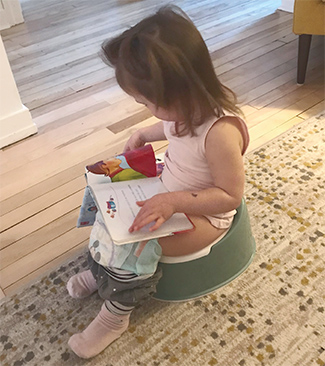Toilet training

![]() The age of toilet training varies greatly from one child to another.
The age of toilet training varies greatly from one child to another.
Photo: Émilie Audy
Toilet training usually begins at about 2 years old. Most children are fully toilet trained through the day between 2 and 4 years old.
Toilet training usually takes from 3 to 6 months. We recommend that you do not set a timetable. There is no use forcing a child who isn’t ready.
Night-time bladder control may take several months or even several years.
A child is capable of toilet training somewhere between 18 months and 3 years of age. Here are a few signs that your child might be ready for this new experience:
- Your child can walk to his potty.
- He is starting to undress (he can pull down his pants).
- His diaper stays dry for several hours.
- He understands simple instructions, like “take this to Daddy.”
- He can express his needs with words like “want milk” and he will soon be able to say “need to pee!”
- He is proud he can do things by himself.
![]() It’s important to go at your child’s speed so this major new step in life is positive. Never try to force him to toilet train before he’s physically and mentally ready. Trust him!
It’s important to go at your child’s speed so this major new step in life is positive. Never try to force him to toilet train before he’s physically and mentally ready. Trust him!
How to make toilet training easier
Here are some ways to make toilet training easier:
- Get him ready a bit at a time by teaching him the words and gestures of elimination – “poop”, “pee”, “potty”, “toilet”.
- Ask him to imitate you. Your child will want to copy you in the bathroom the same way he copies your speech. Put the potty close to the toilet and urge your child to do the same thing you do. When he’s ready, he’ll want to be like mommy and daddy.
- Use the potty rather than the toilet during the first steps. Your child will feel safer and more stable.
- Ensure that he is well seated on the potty, feet on the floor. If he’s too high, use a small footstool so he can relax.
- To begin with, ask your child to sit on the potty with his clothes on, and then again after the wet diaper has been removed.
- Congratulate your child every time he shows interest in sitting on the potty.
- Later, have him sit on the potty at set times of the day (for example, after waking up, after eating and before naps, baths and bedtime) to establish a routine.
- Start using training pants or cotton pants after your child has been using the potty regularly for a few days.
- Don’t be discouraged by accidents. This is all part of learning.
- Encourage his efforts and avoid punishing him if he has an accident.
One of these days your child will want to go in the potty. There’s no rush, and it will be easier if there’s no stress.
![]() It’s not a good idea to start toilet training during an unsettled time in your child’s life, such as when you move, hire a new sitter or a new baby arrives.
It’s not a good idea to start toilet training during an unsettled time in your child’s life, such as when you move, hire a new sitter or a new baby arrives.


